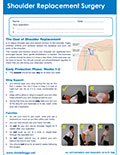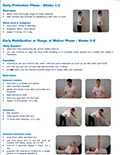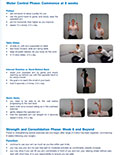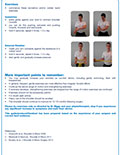Shoulder Joint Replacement
What is the Shoulder?
The shoulder is a complex ball-and-socket joint that allows full movement of the arm.
It offers a wide range of motion, but also makes it vulnerable to injury.
At the shoulder, three major bones meet and create a 90-degree angle. These bones are the
- Collarbone (clavicle)
- The shoulder blade (scapula)
- Humerus, the largest bone of the arm.
Three joints are formed from the junctions of these three bones and the sternum. These joints are the
- Glenohumeral joint,
- Acromioclavicular (AC) joint and
- Sternoclavicular joint.
Each joint in the shoulder is surrounded by cartilage for padding, ligaments to connect the bones, muscles and tendons to attach the muscles to the bones.
Each joint in the shoulder is surrounded by cartilage for padding, ligaments to connect the bones, muscles and tendons to attach the muscles to the bones.
What is Shoulder Joint Replacement?
The surgery is performed under sterile conditions in the operating theatre under spinal or general anaesthesia. An incision is made over the affected shoulder to expose the shoulder joint.
The upper arm bone (Humerus) is separated from the glenoid socket of the shoulder blade (Scapula). The humeral head which is arthritic is cut off.
The surgeon concentrates on the glenoid (socket).
-
The arthritic part of the socket is removed and prepared to take the glenoid component.
-
The glenoid component is then pressed into the socket.
-
The upper arm bone is prepared to take the new humeral component.
The humeral component is then inserted into the upper arm bone. This may be press fit relying on the bone to grow into it or cemented depending on a number of factors such as bone quality and surgeon's preference.
-
The humeral head component is then placed on the humeral stem. This component is made of metal.
-
The artificial components are fixed in place. The Joint capsule is stitched together.
- The muscle and tendons are then repaired and the skin is closed.
Chronic Conditions Requiring Joint Replacement
- Rheumatoid arthritis
- Post-traumatic Arthritis
- Rotator Cuff Tear Arthropathy
- Avascular Necrosis (Osteonecrosis)
- Severe Fractures
- Failed Previous Shoulder Replacement Surgery
Arthritis
Arthritis is a general term covering numerous conditions where the joint surfaces (cartilage) wear out. The joint surface is covered by a smooth articular surface that allows pain free movement in the joint.
This surface can wear out for a number of reasons, often the definite cause is not known.
When the articular cartilage wears out, the bone ends rub on one another and cause pain. There are numerous conditions that can cause arthritis and often the exact cause is never known.
In general, but not always it affects people as they get older (Osteoarthritis).
Other causes include :
- Growth abnormalities of the shoulder
- Trauma (fracture)
- Increased stress, e.g., overuse, overweight.
- Avascular necrosis (loss of blood supply)
- Infection Connective tissue disorders
- Inactive lifestyle, e.g., obesity Inflammation, e.g., Rheumatoid arthritis
Before Shoulder Joint Replacement
Dr Biggs will need to diagnose the specific nature of injury prior to Shoulder Joint Replacement
Diagnostic methods include:
Consultation - During this consultation Dr Biggs will:
- Take a medical history
- Perform a physical examination
- Assess the joint’s range of motion
Blood Test – can determine the condition of the bone and soft tissues of your shoulder
Imaging tests - In order to clearly understand the nature of any loss of the joint space or bone spur formation imaging scans are required:
- X-rays – These images help to determine the extent of damage in your shoulder. They can show loss of the normal joint space between bones, flattening or irregularity in the shape of the bone, bone spurs, and loose pieces of cartilage or bone that may be floating inside the joint.
- MRI - can create detailed images of both hard and soft tissues. An MRI can produce cross-sectional images of internal structures required if the diagnosis is unclear.
- Ultrasound - can allow the doctor to examine the inside of your affected area in motion.
While not all of these approaches or tests are required to confirm the diagnosis, this diagnostic process will also allow Dr Biggs to review any possible risks or existing conditions that could interfere with the surgery or its outcome.
Shoulder Joint Replacement Options
Dr Biggs will evaluate your situation carefully before deciding on the right Shoulder Joint Replacement for you.
There are four types of Shoulder Joint Replacement Surgery.
Total Shoulder Replacement
Typically, the totally shoulder joint replacement surgery involves replacing the arthritic joint surfaces with a highly polished metal ball attached to a stem, and a plastic socket.
Patients with bone-on-bone osteoarthritis and intact rotator cuff tendons are good candidates for conventional total shoulder replacement.
Stemmed Hemiarthroplasty
Depending on the condition of the patient’s Shoulder, Dr Biggs may replace only the ball. This procedure is called hemiarthroplasty.
Typically, the head of the humerus is replaced with a metal ball and stem, similar to the component used in a total replacement.
Resurfacing Hemiarthroplasty
With arthritis of the shoulder, this offers an alternative to the standard stemmed replacement.
Resurfacing Hemiarthroplasty involves replacing the joint surface of the humeral head with a cap-like prosthesis without a stem.
This is a popular option for patients who are young or very active, as it avoids the risk of component wear and loosen that can occur in the other procedure.
Reverse Total Shoulder Replacement
For patients suffering a completely torn rotator cuff, severe arthritis with rotator cuff tearing or have had a failed Shoulder Joint Replacement, a conventional total shoulder replacement may still leave pain and limited mobility.
In reverse total shoulder replacement, the socket and metal ball are switched. That means a metal ball is attached to the shoulder bone and a plastic socket is attached to the upper arm bone. This allows the patient to use the deltoid muscle instead of the torn rotator cuff to lift the arm.
As with any major surgery there are potential risks involved. The decision to proceed with the surgery is made because the advantages of surgery outweigh the potential disadvantages.
It is important that the patient is informed of these risks before the surgery takes place.
Complications can be medical (general) or specific to surgery.
Medical complications include those of the anaesthetic and your general well being. Almost any medical condition can occur so this list is not complete. Complications include:
- Allergic reactions to medications
- Blood loss requiring transfusion with its low risk of disease transmission
- Heart attacks, strokes, kidney failure, pneumonia, bladder infections.
- Complications from nerve blocks such as infection or nerve damage.
Serious medical problems can lead to ongoing health concerns, prolonged hospitalisation or rarely death.
Specific complications for surgery are rare but may include:
Wound irritation- The patient’s scar can be sensitive or have a surrounding area of numbness. This normally decreases over time and does not lead to any problems with your new joint.
Arm length inequality- On rare occasions it is simply not possible to match the arm lengths.
Wear- All joints eventually wear out. The more active you are, the quicker this will occur.
Failure to relieve pain- Very rare but may occur, especially if some pain is coming from other areas such as the spine.
Unsightly or thickened scar- Scar tissue may be visible.
Infection - Infections can occur superficially at the incision or in the joint space of the shoulder, a more serious infection. Infection rates vary; if it occurs it can be treated with antibiotics but may require further surgery.
Shoulder Stiffness - Shoulder stiffness with loss of range of motion is a common complication that can be greatly minimized with strict adherence to your occupational therapy program prescribed by your surgeon.
Dislocations - Dislocations and/or subluxations with activity can occur before healing has taken place. It is very important that you follow your surgeon’s guidelines for activity restrictions.
Damage to nerves of Blood Vessels - Also rare but can lead to weakness or loss of sensation in part of the arm. Damage to blood vessels may require further surgery if bleeding is ongoing.
Damage to the joint - Joint damage to the cartilage or other structures can occur during surgery and may require another operation to repair.
Blood Clots (Deep Venous Thrombosis) - Blood Clots can form in the arm muscles and can travel to the lung (Pulmonary embolism). These can occasionally be serious and even life threatening. If the patient suffers arm pain, redness or swelling, or have shortness of breath at any stage, contact Dr Biggs
Hemarthrosis - A condition caused by excess bleeding into the joint after the surgery is completed. This may require additional surgery to irrigate the joint. e surgery is completed. This may require additional surgery to irrigate the joint.
Surgery Preparation
Once Dr Biggs decides that surgery is required, preparation is necessary to achieve the best results and a quick, problem free recovery.
Preparing mentally and physically for surgery is an important step toward a successful result.
- Dr Biggs will create a treatment plan and
- patients will also need to understand the process and their role in it
Participating and completing a tailored exercise program before (ie. pre-hab) with a trained physiotherapist will achieve the best result after surgery.
Dr Biggs will also need to:
- Discuss any medications being taken with your doctor or physician to see which ones should be stopped before surgery
- Do not eat or drink anything, including water, for 6 hours before surgery
- Stop taking aspirin, warfarin, anti-inflammatory medications or drugs that increase the risk of bleeding one week before surgery to minimise bleeding
- Review blood replacement options (including banking blood) with your doctor
- Stop or cut down smoking to reduce your surgery risks and improve your recovery











